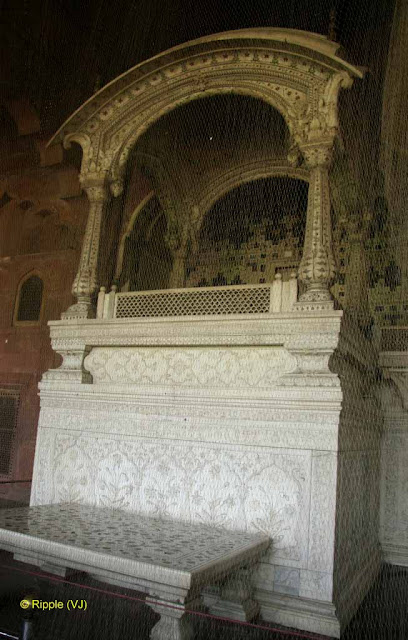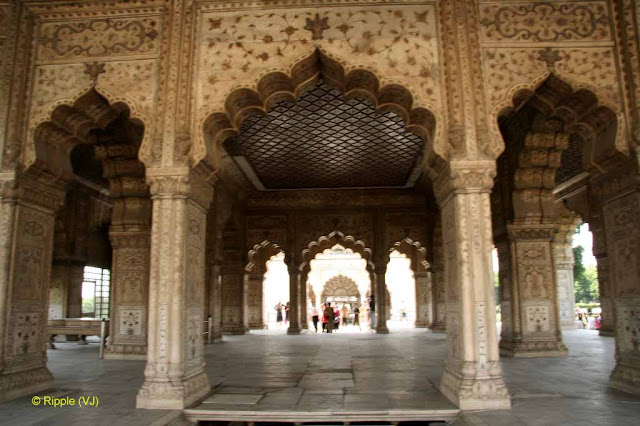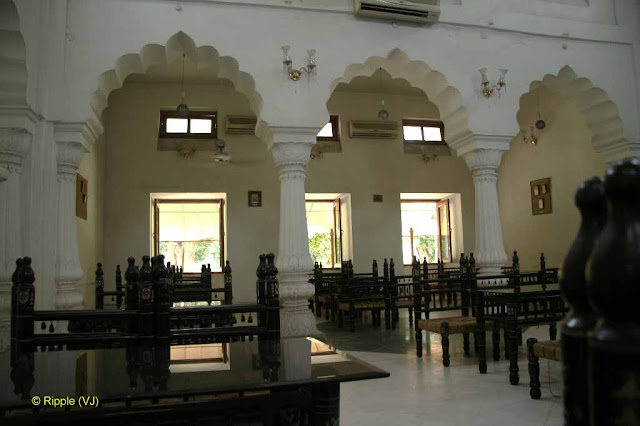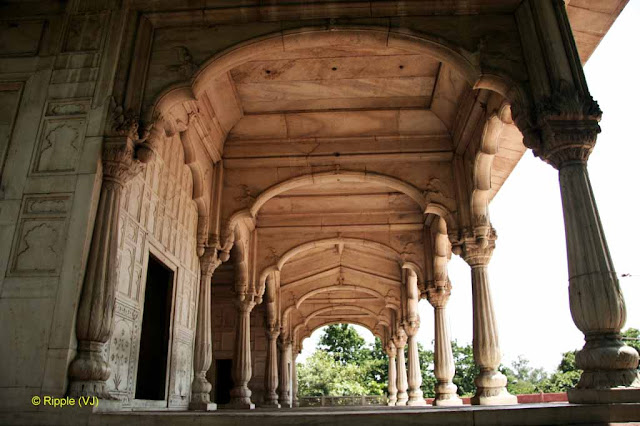Delhi's famous Red Fort is known by that name because of the red stone with which it is built and it is one of the most magnificent palaces in the world. India's history is also closely linked with this fort.


Diwan-I-Aam: Diwan-i-Am or Hall of Public Audience is situated in the Red Fort of Delhi. It originally had a courtyard on its front and was richly ornamented with gilded stuccowork. Heavy curtains graced the main hall, which were three bays in depth.

Front View of Diwan-I-Aam
 Morning sunlight glows on the three rows of red sandstone columns supporting the cusped arches and roof of the Diwan-i-Am pavilion. This, the goal of all his subjects and visitors, was where Shah Jahan held his daily public audiences
Morning sunlight glows on the three rows of red sandstone columns supporting the cusped arches and roof of the Diwan-i-Am pavilion. This, the goal of all his subjects and visitors, was where Shah Jahan held his daily public audiences Shah Jahan's built-in throne in the Diwan-i-Am is one of the glories of the Red Fort. Miraculously surviving the waves of unrest with remarkably little damage, it gives m taste of the original extravagance and supremely high quality of all the Fort decoration. Built of white Makrana marble quarried near Jaipur, the platform walls are carved in relief with clumps of flowers set in decorative borders.
Shah Jahan's built-in throne in the Diwan-i-Am is one of the glories of the Red Fort. Miraculously surviving the waves of unrest with remarkably little damage, it gives m taste of the original extravagance and supremely high quality of all the Fort decoration. Built of white Makrana marble quarried near Jaipur, the platform walls are carved in relief with clumps of flowers set in decorative borders.Khas Mahal: The Khas Mahal is the pavilion of imperial apartments in the palace of the Red Fort of Delhi. It is the third pavilion from the south, in the row of palatial pavilions that stands along the eastern edge of the fort. To its south lies the large zenana, the Rang Mahal, and to its north is the Diwan-i-Khas, the hall of private audience. The Khas Mahal is relatively small, and divided into four main parts. On the south, facing the Rang Mahal, is the Baithak, or sitting room, which is a veranda painted in lavish white and gold floral patterns, with accents in blue and green.

Diwan-I-Khas: The Diwan-i-Khas (‘hall of private audience’) with openings of engrailed arches on its sides consists of a rectangular central chamber surrounded by aisles of arches rising from piers. The lower parts of the piers are inlaid with floral designs, while the upper portions are gilded and painted.
 The Diwan-i-Khas was the Emperor's private audience hall, a riverside palace reserved for ministers and high-ranking, favored visitors. Here Shah Jahan sat on his Peacock Throne at the center of his Fort, cooled by riverside breezes wafting through the floor-level windows, soft light reflecting off the gilded ceilings and walls, fine silk rugs strewn on the marble floor.
The Diwan-i-Khas was the Emperor's private audience hall, a riverside palace reserved for ministers and high-ranking, favored visitors. Here Shah Jahan sat on his Peacock Throne at the center of his Fort, cooled by riverside breezes wafting through the floor-level windows, soft light reflecting off the gilded ceilings and walls, fine silk rugs strewn on the marble floor. Emperor Shah Jahan, builder and patron of the arts, is shown here seated in the jewel-encrusted Peacock Throne he commissioned. The jewel merchant Jean Baptist Tavernier declared it to be 'the principal of seven magnificent thrones, one wholly covered with diamonds.
Emperor Shah Jahan, builder and patron of the arts, is shown here seated in the jewel-encrusted Peacock Throne he commissioned. The jewel merchant Jean Baptist Tavernier declared it to be 'the principal of seven magnificent thrones, one wholly covered with diamonds. Diwan-i-Khas, the most richly decorated of all the Red Fort buildings, was Shah Jahan's private audience hall for the equivalent of his cabinet meetings.
Diwan-i-Khas, the most richly decorated of all the Red Fort buildings, was Shah Jahan's private audience hall for the equivalent of his cabinet meetings.Hammam: Accompanying the Diwan-i-Khas, or Hall of Selective Audience, the Hamam (bathroom set) consists of three apartments interconnected by corridors. The marble floors and dados are inlaid with beautiful floral patterns of multi-colored stones. The princes and princesses used two of these apartments to bathe, while the third one, with three fountain basins, emitted rose water and was used as the dressing room. The western apartment was fixed with heating arrangement and was mainly used for the hot bath or vapor bath.

Hammam & Moti Masjid: The personal mosque of Aurungzeb, Moti Masjid or Pearl Mosque lies to the west of Hamam.
Hayat-Bakhsh Garden And The Pavilions: The area north of the Moti-Masjid is occupied by a garden, called the Hayat-Bakhsh-Bagh (life-bestowing garden), divided into squares on the pattern of Mughal gardens with causeways and channels between them. It finds mention in the contemporary accounts, althouth its present layout in new. At the north-eastern corner of the garden is a tower, called "Shah-Burj", now domeless, which suffered much during the Mutiny. A similar tower known as Asad-Burj stands on the south-eastern corner of the fort. The water for feeding the Nahr-i-Bihisht was apparently lifted up to the Shah-Burj from the river and then carried by channels to the various palaces.
Hayat-Bakhsh Garden And The Pavilions: The area north of the Moti-Masjid is occupied by a garden, called the Hayat-Bakhsh-Bagh (life-bestowing garden), divided into squares on the pattern of Mughal gardens with causeways and channels between them. It finds mention in the contemporary accounts, althouth its present layout in new. At the north-eastern corner of the garden is a tower, called "Shah-Burj", now domeless, which suffered much during the Mutiny. A similar tower known as Asad-Burj stands on the south-eastern corner of the fort. The water for feeding the Nahr-i-Bihisht was apparently lifted up to the Shah-Burj from the river and then carried by channels to the various palaces.

Zafar-Mahal: In the centre of the garden is a large tank with a red stone pavilion in its middle, originally connected by a causeway with the garden.


CLICK on below mentioned links to explore other places in DELHI :




.jpg)
Comments
This is really a very good stuff.
Keep on going.